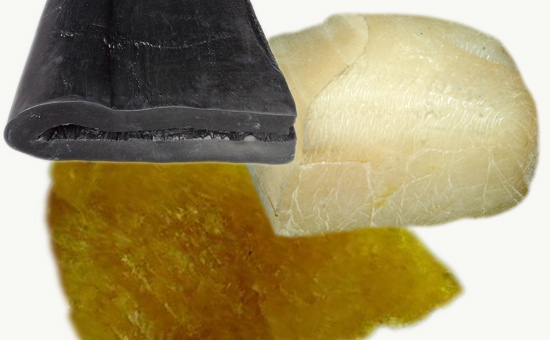
Synthetic recycled rubber, that is, synthetic rubber regeneration, mainly includes butyl reclaimed rubber, nitrile reclaimed rubber and EPDM reclaimed rubber. These synthetic reclaimed rubbers are generally used to replace the same kind of synthetic rubber to produce rubber products to reduce production costs. However, in practical applications, synthetic reclaimed rubber can also be blended into other types of rubber. Xiaobian today uses butyl reclaimed rubber as an example to discuss the blending of butyl reclaimed rubber with natural rubber and styrene-butadiene rubber. Mechanism and role of butyl reclaimed rubber in the blend system.
Butyl rubber is synthesized from isobutylene and a small amount of isoprene. It has good air tightness, heat resistance, ozone resistance, aging resistance and chemical properties. However, it has poor compatibility with other types of rubber. Generally, it can only be used with ethylene propylene rubber. It is used together with polypropylene rubber; butyl reclaimed rubber mostly uses waste butyl inner tube as the main raw material (some butyl reclaimed rubber will be added with butyl rubber). Compared with butyl rubber, its molecular weight is small, its molecular structure is irregular, and it contains a small amount. Unsaturated double bond, insoluble gel, free sulfur, combined sulfur, resin, vulcanizing agent, accelerator, etc., has strong vulcanization reaction, and provides good compatibility for butyl reclaimed rubber/natural rubber/styrene-butadiene rubber blending rubber. Sex and blending conditions.
Butyl reclaimed rubber is composed of many small molecules, contains a certain amount of carbon black, and has certain performance characteristics of carbon black. When butyl reclaimed rubber is used as a filler, it is used in the combination of natural rubber/styrene-butadiene rubber. It is first wetted by a low-viscosity rubber and dispersed in it to provide a certain reinforcing effect. With the addition of butyl reclaimed rubber, the viscosity of the low-viscosity rubber in the blend of natural rubber and styrene-butadiene rubber will increase, shortening the two The difference in viscosity between the three rubber blends has a small rubber phase structure.
As a rubber in the blended rubber, butyl reclaimed rubber will form an interfacial layer between natural rubber and styrene-butadiene rubber. At a certain vulcanization temperature, the intermolecular motion energy increases, and the mutual solubility of the rubber increases. The entangled structure formed by the macromolecules in the layer may be fixed to become an effective physical crosslink; the butyl reclaimed rubber itself has a low degree of crosslinking, while the natural rubber and styrene-butadiene rubber have high reactivity, so under the action of the vulcanizing agent The diene double bond of the butyl reclaimed rubber in the transition layer will produce cross-linking; the butyl reclaimed gel contains a gel having a small network shape, which can accelerate the vulcanization of the butyl reclaimed rubber/natural rubber/styrene-butadiene rubber blend system. At the speed, the three-glue phase produces a transition layer co-vulcanization to enhance the stability of the transition layer.
Butyl reclaimed rubber can improve the fatigue resistance and aging resistance of natural rubber/styrene-butadiene rubber blending system. This is because the addition of butyl reclaimed rubber increases the adhesion in the blending system and realizes the blending system interface. The co-vulcanization of the transition layer enhances the intermolecular forces, thereby improving the resistance to external forces and reducing hysteresis losses.
Butyl reclaimed rubber and high-unsaturated diene rubber (natural rubber styrene butadiene rubber are high-unsaturated diene rubber) can be interfacially blended between rubber phases by a reasonable blending method. Transition layer vulcanization, improve blending adhesive compatibility, adhesion and fatigue resistance, aging resistance, reduce hysteresis loss; rubber manufacturers can use these advantages to use butyl reclaimed rubber in highly unsaturated diene rubber In the production of products, the mixing process is improved, the comprehensive performance of rubber products is improved, and the production cost is reduced.
Exclusive original article [commercial authorization] reprint, excerpt and excerpt in any form are prohibited without written authorization. Focus on Hongyun rubber: learn the process formula and raw material technology of producing rubber products from recycled rubber to help you reduce costs and increase profits